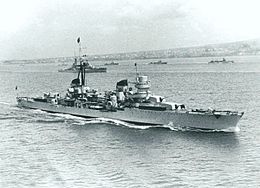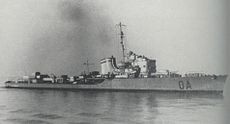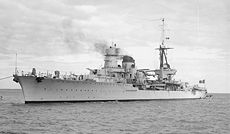- Operation Harpoon (1942)
-
Not to be confused with Operation Harpoon (2002)
Operation Harpoon Part of the Mediterranean Theater of World War II 
Light cruiser Eugenio di Savoia, Admiral Da Zara's flagshipDate 12–15 June 1942 Location Western Mediterranean, toward Malta Result Axis victory
Italian naval victory[1]
Only two Allied freighters reached MaltaBelligerents  United Kingdom
United Kingdom
 Poland
Poland Italy
Italy
 Germany
GermanyCommanders and leaders Alban Curteis
Cecil Campbell HardyAlberto da Zara Strength 2 aircraft carriers
1 battleship
4 light cruisers
1 minelayer
17 destroyers
4 minesweepers
6 motor launches
6 merchant ships
Spitfire fighters
Beaufighter fighters
Sea Hurricane fighters
Fairey Fulmar fighters
Fairey Swordfish torpedo bombers2 light cruisers
5 destroyers
Ju 87 dive-bombers
Ju 88 bombers
SM.79 torpedo-bombers
Bf 109 fighters
Bf 110 fighters
Cr.42 fighters
Mc.200 fighters
Mc.202 fighters
Re.2000 fighters
Re.2001 fightersCasualties and losses 2 destroyers sunk
4 merchant ships sunk
2 light cruisers damaged
3 destroyers damaged
1 minesweeper damaged
1 merchant ship damaged
200+ prisoners1 destroyer damaged U-boat Campaign – Club Run¹ –- Malta Convoys¹ –- Espero¹² – Mers-el-Kébir – Calabria¹² – Cape Spada – Cape Passero¹ – Taranto – Strait of Otranto² – White¹ – Cape Spartivento¹ – Excess¹ – Abstention – Souda Bay – Matapan – Tarigo² – Crete – Substance¹ – Halberd¹ – Duisburg² – Bon² – December 1941² – 1st Sirte¹² – Alexandria raid – 2nd Sirte¹ – Calendar – Harpoon¹ – Vigorous¹ – Pedestal¹ – Agreement – Torch – Stone Age¹ – Toulon – Portcullis¹ – Skerki² – Algiers¹ – Cigno² – Sicily – Olterra's campaign¹ – Sinking of Roma – Dodecanese Campaign – Cape Bougaroun¹ – Port Cros – La Ciotat¹ - Involved an Allied convoy • ² - Involved an Axis convoy Operation Harpoon was one of two simultaneous Allied convoys sent to supply Malta in the Axis-dominated Mediterranean Sea in mid-June 1942, during the Second World War. One convoy, Operation Vigorous, left Alexandria. The other, Operation Harpoon, travelled in the opposite direction from Gibraltar. Both convoys met with fierce Axis opposition and only two of Harpoon′s six merchant ships completed the journey, at the cost of several Allied warships.
They were followed by Operation Pedestal.
Contents
Background
Until the French surrender and Italy's declaration of war, the Mediterranean had been an Allied "lake". The French Fleet and the Royal Navy's Mediterranean Fleet dominated the only potential and credible adversary, Italy's Regia Marina.
The French surrender and its consequences changed that. The French Fleet became a potentially potent threat in Axis hands and so was, in part, destroyed, adding to French antipathy toward the British. French bases in North Africa ceased to offer protection to Allied shipping. The Regia Marina possessed potent modern warships, particularly battleships and heavy cruisers, and Italian and Libyan territory provided centrally located naval and air bases that could cut British supply routes. The fall of Greece and Crete in 1941 extended the reach of Axis forces which were consequently able to intercept Allied shipping from Alexandria and Suez by air.
Italian and German armies in Libyan territory also threatened Egypt and the control of the strategically important Suez Canal. A catastrophe in Egypt might in turn lead to destabilisation of Britain's control of Middle Eastern oil supplies, or even worse, to the Axis gaining control of them. This apocalyptic scenario depended upon Axis forces in North Africa receiving adequate supplies from Italy.
Malta threatened this Axis supply route, but itself needed regular resupply and reinforcement, in order to be effective and to resist Axis invasion.
By mid-June, 1942, Malta's supply situation had deteriorated. The Luftwaffe had joined the Regia Aeronautica to isolate and starve the island and it had become untenable as an offensive base. Axis armies had advanced into Egypt and Crete thereby acquiring their own advance bases and denying the British safety over much of the eastern Mediterranean.
Fresh aircraft were regularly flown in to Malta, but food and fuel were diminishing. In response, Britain invested large amounts of effort to ensure resupply. Two convoys, codenamed Harpoon and Vigorous, were gathered, sailing simultaneously to split Axis forces. To contest the two Malta convoys, the Axis airforces had a total of 347 Italian and 128 German aircraft in the western Mediterranean, of which 175 Italian aircraft were based in Sardinia, with the rest in Sicily while 53 Italian and 122 German aircraft were based in the eastern Mediterranean; a total of 650 aircraft, although not all were operational.[2]
A series of British naval disasters[3] allowed the Regia Marina to gain naval supremacy in the east-central Mediterranean. The Italian Fleet took advantage of the situation and moved onto the offensive, blocking or decimating at least three large British convoys bound for Malta. This led to a number of naval engagements, such as the Second Battle of Sirte, the Battle of Mid-June or Operation Harpoon (plus Operation Vigorous) and finally to Operation Pedestal, all of them favourable to the Axis. However, the only real success of the Italian Fleet was the attack on the Harpoon convoy.
The convoy
Harpoon left Gibraltar on 12 June 1942, comprising six merchantmen (Troilus, Burdwan and Orari from Britain; Tanimbar from Holland and the Chant and the tanker Kentucky from the U.S.) carrying a total of 43,000 short tons (39,000 t) of cargo and oil. They were escorted by the anti-aircraft cruiser HMS Cairo, nine destroyers, the fast minelayer HMS Welshman[4] and smaller ships. Distant cover was provided by the battleship HMS Malaya, the aircraft carriers HMS Argus and Eagle, the cruisers HMS Kenya, Charybdis and Liverpool, and a number of destroyers.[5]The two aircraft carriers embarked a total of 16 Sea Hurricanes, six Fairey Fulmars, and 18 Fairey Swordfish.[6]
The operation
The first Italian air attacks, on the 14th, sank one freighter, the Tanimbar, south of Sardinia with Savoia-Marchetti SM.79 torpedo bombers. The cruiser HMS Liverpool was damaged and towed back to Gibraltar by HMS Antelope, under aerial attacks, arriving there on the 17th. Later on 14 June, the covering force also returned to Gibraltar, just before the Strait of Sicily.[7] On the same day, the fast minelayer HMS Welshman was detached and traveled to Malta alone, where she delivered some cargo, then sailed back to strengthen the convoy's escort on the 15th.
 The Italian Poeti-class destroyer Oriani
The Italian Poeti-class destroyer Oriani
 The Italian Condottieri-class cruiser Raimondo Montecuccoli.
The Italian Condottieri-class cruiser Raimondo Montecuccoli.
Next day, the 15th, the now lightly defended convoy was subjected to a coordinated attack, near Pantelleria, by Axis aircraft and the ships of the Italian 7th Division (cruisers Raimondo Montecuccoli, Eugenio di Savoia and destroyers Ascari, Oriani, Malocello, Premuda and Vivaldi), commanded by Vice-Admiral Alberto da Zara.
The five fleet destroyers in the convoy escort made a smokescreen and attacked the Italian squadron, but the Tribal-class destroyer HMS Bedouin and the P-class destroyer tanker Kentucky, Chant and the freighter Burdwan—were disabled by air attack, abandoned and later sunk by gunfire and torpedoes from Raimondo Montecuccoli and the destroyers Ascari and Oriani. Chant had already been sent to the bottom by aerial bombs when the Italian squadron found her still smoldering wreckage site.[9][10][11] The cruiser HMS Cairo and the minesweeper HMS Hebe also received hits from Italian gunfire.[11]
Partridge was recovered and even tried to tow Bedouin, but then the Italian cruisers with two destroyers reappeared; the tow was cast off, leaving Bedouin adrift.
Partridge managed to withdraw and head back for Gibraltar, but Bedouin—already shattered by at least twelve 6 in (150 mm) shells plus several near misses and listing heavily—was finally sunk by aerial torpedoes. Twenty-eight of her crew died and more than 200 were taken POWs.[12]
 Another Regia Marina 7th Division victim: The crippled destroyer HMS Bedouin was finished off by an aerial torpedo from a Savoia-Marchetti SM.79 bomber.
Another Regia Marina 7th Division victim: The crippled destroyer HMS Bedouin was finished off by an aerial torpedo from a Savoia-Marchetti SM.79 bomber.
In the evening of the 15th, the surviving ships ran into a minefield off Malta. The destroyers HMS Badsworth and Matchless and another freighter (Orari) struck mines there and were damaged, while the Polish destroyer ORP Kujawiak sank after midnight.[13]
Just two of the original six merchantmen reached Malta, the Orari and Troilus, the former losing some of her cargo due to the mine explosion. HMS Hebe also struck a mine and suffered further damage, but after a month in dry dock she was seaworthy again.[14]
Aftermath
This was the only undisputed squadron-sized victory for the surface forces of the Italian navy in World War II.[1] The British report of the battle acknowledges that Kentucky and Burdwan "without the Italian naval force would have both reached their destination".[15] However, it should be remembered that, at this stage, any supplies reaching Malta were an Allied success. Furthermore, Royal Navy Fleet Air Arm fighters shot down 13 Axis aircraft while ship's gunners destroyed 16 more, for a total of 29 Axis aircraft shot down during the battle.[16] But the supplies delivered by Operation Harpoon were insufficient and fuel for the Malta's RAF contingent was running low, in great part due to the sinking of the Kentucky.[17]
On 1 September 1942, the award of various decorations for participants in the operation were announced in the London Gazette, there were six appointments to the Distinguished Service Order, and one bar, two Distinguished Service Crosses, three Distinguished Service Medals and nine officers were Mentioned in Despatches.[18]
The next, and critical, convoy was Operation Pedestal: it would decide the fate of Malta.
Order of battle
Allies
- Force X - convoy escort - Capt. Cecil Campbell Hardy
- light cruiser (AA) HMS Cairo # (flag)
- minelayer HMS Welshman
- destroyers: HMS Bedouin†, Marne, Matchless ##, Ithuriel, Alban Curteis
- battleship: HMS Malaya
- aircraft carriers: HMS Eagle, Argus
- light cruisers: HMS Kenya (flag), Liverpool ##, Charybdis
- destroyers: HMS Onslow, Icarus, Escapade, Antelope, edit] Italy
- 7 Division (Vice-Admiral Alberto da Zara):
- light cruisers: Eugenio di Savoia (flag), Raimondo Montecuccoli
- destroyers: Alfredo Oriani, Ascari, Ugolino Vivaldi ##, Lanzerotto Malocello, Premuda
- † - ships sunk
- # - ships damaged, ## - heavily damaged
See also
Footnotes
- ^ a b "Clearly this was an Axis victory and a tactical victory for the Italian Navy. Part of the convoy did get through to Malta, but the British suffered far heavier losses than did the Italians and Mussolini would later personally present medals to Da Zara and some of his men for their efforts. It would be the only squadron-sized surface naval victory of the war for Italy." Greene & Massignani, page 238
- ^ Sadkovitch, The Italian Navy in World War II, p257
- ^ See First Battle of Sirte and Luigi Durand De La Penne articles
- ^ Arnold Hague: The supply of Malta 1940-1942, Part 1 of 3
- ^ Woodman, pp. 329-330
- ^ Naval Staff History, The Royal Navy and the Mediterranean Convoys, Appendix J
- ^ Thomas, page 158
- ^ Bragadin, page 181
- ^ Bragadin, page 184
- ^ Woodman, page 339
- ^ a b Ireland, page 133
- ^ Greene & Massignani, page 238
- ^ Arnold Hague: The supply of Malta 1940-1942, Part 1 of 3. 13 men of the Kujawiak complement loss their lives
- ^ Bragadin, page 185
- ^ Bragadin, page 186
- ^ Naval Staff History, The Royal Navy and the Mediterranean Convoys, page 67.
- ^ "But as the all-important US tanker Kentucky had been sunk the oil and kerosene situation became desperate." Smyth, page 132
- ^ London Gazette: (Supplement) no. 35687. p. 3818. 28 August 1942. Retrieved 29 July 2009.
External links
- London Gazette: (Supplement) no. 38377. pp. 4495–4512. 10 August 1948. The official despatch to the Admiralty describing Operation Harpoon.
- Operation Harpoon
- Order of battle
- Italian Cruiser Montecuccoli
- Battaglia di Mezzo Giugno - Plancia di Commando
Sources
- Bragadin, Marc'Antonio (1957). The Italian Navy in World War II, United States Naval Institute, Annapolis. ISBN 0-405-13031-7.
- Green, Jack & Massignani, Alessandro (1998). The Naval War in the Mediterranean, 1940-1943, Chatam Publishing, London. ISBN 1-885119-61-5.
- Ireland, Bernard (2004). The War in the Mediterranean 1940-1943. Leo Cooper. ISBN 1-84415-047-X.
- Smyth, John George (1970) The Valiant. A. R. Mowbray. ISBN 0-264-64510-3.
- Woodman, Richard (2000). Malta Convoys, 1940-1943, Jack Murray Ltd., London. ISBN 0-7195-5753-4.
- Thomas, David A. (1999) Malta Convoys, Leo Cooper Ed., South Yorkshire. ISBN 0-85052-663-9.
- 7 Division (Vice-Admiral Alberto da Zara):
Categories:- Battle of the Mediterranean
- Malta Convoys
- Naval aviation operations and battles
- Naval battles of World War II involving Italy
- Naval battles of World War II involving the United Kingdom
- Aerial operations and battles of World War II involving the United Kingdom
- 1942 in Malta
- Conflicts in 1942
- Force X - convoy escort - Capt. Cecil Campbell Hardy
Wikimedia Foundation. 2010.

